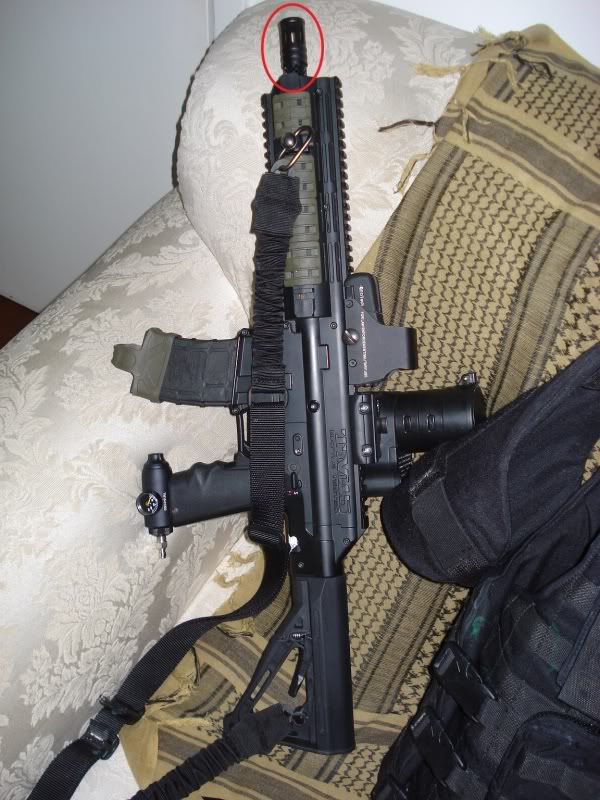AsdEspada escreveu:Arrigow escreveu:Jogo a 240fps CRONADISSÍMO! Sem mais.

Hmmm...vou tentar...mas com 240fps, não acaba perdendo distância?

Bom, vou testar depois posto! Valeu!

Brow...este é o FAQ da HH, eu sigo estas instruções e sigo a risca os itens 2 e 3:
How do I maximize accuracy with my barrel?
1. Choose the correct Fin size. If the sizer is too large for the paint you will are may see much improvement over a standard smooth bore. The ball sizer and the barrel system all work together to provide the high level of accuracy we are striving to achieve. If the Fin size is too small you will break paint. The correct fin choice will allow just a little bit of resistance against the ball. Be sure to check the size of your paint if the humidity and air temp change a lot during the day. Temp and humidity effect paint size.
2. Paint quality: The most important criteria for paintball accuracy is paint quality. While our barrel has been shown to handle lower grade better than a smooth bore, Old or highly dimpled paint is difficult for any barrel to perform well with. Old paint has a tendency to become oblong, swell, and develop flat spots. Any barrel’s performance is directly related to the quality of paint you shoot.. The Hammerhead system provides help in shooting poor quality paint over a polished musket barrel, however, good paint always results in better results. We like to see players use good paint, but our barrel system will still shoot better than a polished bore due to the ball rotation. Our players say “Save paint, Shoot a Hammerhead!”. So you can choose to shoot accurate with less shots, or spray and pray, so it is much easier to justify spending a little bit more on better paint. Players are able to put a lot more paint where they want it to go reducing the need to paint and spray with our system.
3. Velocity: The rifling of the Hammerhead was designed to work best between 260 and 280fps. The ball rotation requirement to develop a cone of eddy currents behind the ball to minimize ball drag, and minimize eddy currents and knuckle-balling is designed at 280 ft/sec. Ball velocity greater than 280 ft/sec results in greater ball rotation which can develop ball Yaw, or curvature. Speed less than about 260 ft/sec does not fully develop the required ball rotation need to achieve optimum ball rotation and accuracy. Avoid shooting above 300fps. Any velocity less than about 285 ft/sec should perform well.
4. Muzzle Design: The reverse ported muzzles we manufacture are all reverse ported in some manner. The muzzles are counter-bored which results in a greater bore diameter than the barrel. The effects of a muzzle with a greater diameter than the barrel has the effect of reducing air pressure in front of the ball as the ball transitions at the interface of the barrel-to-muzzle transition. The reduction in pressure at the transition allows the pressure on the back side of the ball and the front side of the ball to become more neutral, allowing the ball to regenerate it’s shape, or become more “round again” since it shape became non-uniform when the force of the bolt was acted upon it. The reduction in pressure at the counter-bored barrel/muzzle interface (Venturing effect) allows air to enter the reverse ports reducing the turbulence at the muzzle exit resulting in a less-turbulent ball release at the muzzle exit. Less turbulence at the muzzle exit further contributes to long-ball accuracy.
5. What are the effects of Rifling on Ball breaks?: In the fire-arm industry, Rifling is described in terms of “lands and grooves”. During barrel development, we built barrels with varying rifling rotation rates, land widths, and depths to develop a specific ball rotation rate when shooting at the legal rate of 280 ft/sec. The riflings of the Hammerhead barrels are continuous from the marker breach to the barrel muzzle. The reverse ported and counter-bored muzzles create a venturi effect when the balls pass from the barrel to the counter-bored muzzle. The venturi effect results in a lower pressure at the muzzle. This combination allows broken paint to travel down the rifled grooves and exhausted at the reverse ported muzzle. Typically, the design allows broken paint to self-clean in a few shots. However, there are some paints like Evil, and Ultra-Evil which are high-quality thick paints that are hard for any barrel to clean out however. A highly polished mirco-honed barrel with no riflings (musket-type barrel) has a surface area of high surface tension (like glass), that is difficult to clean by simply shooting balls through it.






